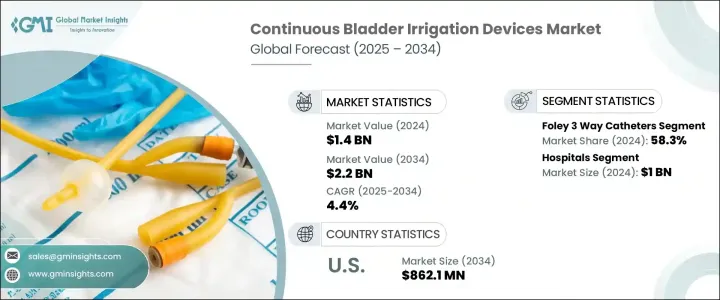
|
시장보고서
상품코드
1750272
세계의 지속적 방광 세정 장치 시장 : 시장 기회, 성장 촉진요인, 산업 동향 분석, 예측(2025-2034년)Continuous Bladder Irrigation Devices Market Opportunity, Growth Drivers, Industry Trend Analysis, and Forecast 2025 - 2034 |
||||||
세계의 지속적 방광 세정 장치 시장은 2024년에는 14억 달러로 평가되었고 방광암, 혈뇨, 전립선 비대증(BPH) 등의 비뇨기과질환 유병률 증가에 의해 CAGR 4.4%로 성장하여 2034년에는 22억 달러에 이를 것으로 추정되고 있습니다.의료 제공업체가 합병증을 줄여, 환자 회복을 개선하는 것을 목표로 하고 있기 때문에 CBI 시스템은 병원이나 임상 현장에서 필수적인 것이 되고 있습니다.특히 비뇨기과수술 후 수술후 케어에서는 혈전 형성 방지와 카테터 기능 유지에 도움이 되기 위해, 이러한 시스템은 매우 중요합니다.

카테터 소재와 디자인, 세척 공급 시스템의 기술 발전은 지속적 방광 세척(CBI) 장치의 기능성과 신뢰성을 크게 변화시켰습니다. 꼬임 방지 튜브, 압력 제어 흐름 메커니즘, 개선된 풍선 디자인과 같은 기술 혁신은 환자의 안전과 임상의 사용 편의성을 향상시켰습니다. 이러한 발전은 소변의 흐름을 더 잘 제어하고, 카테터 막힘을 줄이며, 보다 효과적인 혈전 관리를 가능하게 했습니다. 또한, 최신 CBI 시스템에는 오염 위험을 최소화하는 기능이 내장되어 있어 카테터 관련 요로감염(CAUTI)을 줄이기 위한 병원의 노력을 지원합니다. 그 결과, 첨단 CBI 장비는 수술 후 및 장기적인 비뇨기과 치료에서 환자의 결과를 유지하는 데 필수적인 요소로 자리 잡았습니다.
| 시장 범위 | |
|---|---|
| 개시 연도 | 2024 |
| 예측연도 | 2025-2034년 |
| 개시 금액 | 14억 달러 |
| 예측 금액 | 22억 달러 |
| CAGR | 4.4% |
3-way 폴리 카테터는 2024년 58.3%로 가장 큰 시장 점유율을 차지했으며, 이는 수술 후 출혈 관리 및 카테터 개존성 유지에 널리 채택되고 있음을 반영합니다. 이 카테터는 세척, 풍선 팽창, 배뇨가 가능하여 복잡한 비뇨기과 질환의 치료에 필수적입니다. 수술 후 사용뿐만 아니라 외상으로 인한 방광 손상, 화학요법으로 인한 방광염, 기타 요폐 합병증 등에도 사용되어 의료용 카테터는 전 세계적으로 그 사용 범위가 넓어지고 있습니다.
방광 종양 절제술, 전립선 수술 등 혈전 저류를 방지하기 위해 지속적인 세척이 필요한 수술의 빈도가 높기 때문에 병원 부문은 2024년 지속적 방광 세척 장치 시장에서 가장 큰 점유율을 차지할 것으로 예측됩니다. 카테터 관련 요로감염(CAUTI)의 감소에 대한 관심이 높아지면서 병원들은 환자의 안전과 수술의 성공을 지원하기 위해 첨단 CBI 시스템에 대한 투자를 늘리고 있습니다. 수술 후 합병증을 최소화하는 데 있어 지속적 방광 세척의 역할은 비뇨기과 입원 치료의 표준이 되고 있습니다.
미국의 지속적 방광 세척 장치 시장은 2024년 5억 6,930만 달러에 달할 것으로 예측됩니다. 이는 미국 노인 인구 증가로 인해 전립선 비대증, 방광암, 혈뇨의 발생률이 높아지고 있으며, 이러한 질환은 장기적인 세척 솔루션이 필요한 경우가 많기 때문입니다. 이러한 인구 추세는 신뢰할 수 있는 수술 후 세척이 필요한 경요도 수술과 같은 방광 관련 수술 증가에 직접적으로 기여하고 있습니다. 병원과 수술센터는 내구성, 감염 저항성, 유지보수 용이성을 제공하는 고품질 세척 시스템을 우선시하고 있습니다.
Cardinal Health, C. R. Bard, Sterimed, Baxter, Advin Health Care, Teleflex, Angiplast, HEMC, Medline, Bactiguard, Boston Scientific, Coloplast, AdvaCare, B. Braun, Vogt Medical 등 주요 기업들은 시장에서의 입지를 강화하는 전략을 취하고 있습니다. AdvaCare, B. Braun, Vogt Medical 등 주요 기업들은 시장에서의 입지를 강화하기 위해 집중적인 전략을 채택하고 있습니다. 여기에는 카테터 재료의 제품 혁신, 의료기관과의 전략적 파트너십, 신흥 시장 진출 등이 포함됩니다. 또한, 감염 제어 기능을 강조하고, 맞춤형 솔루션을 제공하고, 규제 기준을 충족하고, 치료 결과를 개선하기 위해 연구개발에 투자하고 있습니다.
목차
제1장 분석 방법과 범위
제2장 주요 요약
제3장 업계 인사이트
- 생태계 분석
- 업계에 대한 영향요인
- 성장 촉진요인
- 업계의 잠재적 리스크와 과제
- 성장 가능성 분석
- 트럼프 정권의 관세에 대한 영향
- 무역에 대한 영향
- 무역량 혼란
- 보복 조치
- 업계에 대한 영향
- 공급측 영향(원재료)
- 주요 원재료의 가격 변동
- 공급망 재구축
- 생산비용에 대한 영향
- 수요측 영향(판매 가격)
- 최종 시장에의 가격 전달
- 시장 점유율 동향
- 소비자 반응 패턴
- 공급측 영향(원재료)
- 영향을 받는 주요 기업
- 전략적인 업계 대응
- 공급망 재구성
- 가격 결정과 제품 전략
- 정책 관여
- 전망과 향후 고려사항은 관세 정권보다 중요
- 무역에 대한 영향
- 향후 시장 동향
- 규제 상황
- Porter's Five Forces 분석
- PESTEL 분석
제4장 경쟁 구도
- 서론
- 경쟁 대시보드
- 기업 매트릭스 분석
- 주요 기업 경쟁 분석
- 경쟁 포지셔닝 매트릭스
- 전략적 전망 매트릭스
제5장 시장 추산·예측 : 제품별(2021-2034년)
- 주요 동향
- 폴리 3 way 카테터
- 실리콘 카테터
- 라텍스 카테터
- 부속품
- 세정 세트
- 롤러 클램프
- 아울렛 백
- 세정용 백
제6장 시장 추산·예측 : 최종 용도별(2021-2034년)
- 주요 동향
- 병원
- 장기요양시설
- 기타 용도
제7장 시장 추산·예측 : 지역별(2021-2034년)
- 주요 동향
- 북미
- 미국
- 캐나다
- 유럽
- 독일
- 영국
- 프랑스
- 이탈리아
- 스페인
- 네덜란드
- 아시아태평양
- 일본
- 중국
- 인도
- 호주
- 한국
- 라틴아메리카
- 멕시코
- 브라질
- 아르헨티나
- 중동 및 아프리카
- 남아프리카공화국
- 사우디아라비아
- 아랍에미리트(UAE)
제8장 기업 개요
- AdvaCare
- Advin Health Care
- Angiplast
- B. Braun
- Bactiguard
- Baxter
- Boston Scientific
- C. R. Bard
- Cardinal Health
- Coloplast
- HEMC
- Medline
- Sterimed
- Teleflex
- Vogt Medical
The Global Continuous Bladder Irrigation Devices Market was valued at USD 1.4 billion in 2024 and is estimated to grow at a CAGR of 4.4% to reach USD 2.2 billion by 2034, driven by the increasing prevalence of urological conditions such as bladder cancer, hematuria, and benign prostatic hyperplasia (BPH). As healthcare providers aim to reduce complications and improve patient recovery, CBI systems have become essential in hospitals and clinical settings. These systems are particularly vital during post-operative care following urologic surgeries, as they help prevent clot formation and maintain catheter function.

Technological progress in catheter materials, design, and irrigation delivery systems has significantly transformed the functionality and reliability of continuous bladder irrigation (CBI) devices. Innovations such as anti-kink tubing, pressure-controlled flow mechanisms, and improved balloon designs have enhanced patient safety and clinician ease-of-use. These advancements contribute to better control of urine flow, reduced catheter blockages, and more effective clot management. Additionally, modern CBI systems incorporate features that minimize the risk of contamination, supporting hospitals' efforts to reduce catheter-associated urinary tract infections (CAUTIs). Healthcare protocols now place a strong emphasis on standardized irrigation practices, as a result, advanced CBI devices have become a critical component in maintaining patient outcomes in post-operative and long-term urological care.
| Market Scope | |
|---|---|
| Start Year | 2024 |
| Forecast Year | 2025-2034 |
| Start Value | $1.4 Billion |
| Forecast Value | $2.2 Billion |
| CAGR | 4.4% |
Foley 3-way catheters held the largest market share at 58.3% in 2024, reflecting their widespread adoption in managing post-surgical bleeding and maintaining catheter patency. These catheters are capable of irrigation, balloon inflation, and urine drainage, making them indispensable in treating complex urological conditions. Beyond their post-operative use, these catheters are also utilized in trauma-related bladder injuries, chemotherapy-induced cystitis, and other urinary retention complications, which have widened their application in healthcare worldwide.
The Hospitals segment in the continuous bladder irrigation devices market held the largest share in 2024 due to the high frequency of procedures like bladder tumor resections and prostate surgeries, which require consistent irrigation to prevent blood clot retention. With an increasing focus on reducing catheter-associated urinary tract infections (CAUTIs), hospitals are investing more in advanced CBI systems that support patient safety and surgical success. The role of continuous bladder irrigation in minimizing post-surgical complications has made it a standard element in inpatient urological care.
United States Continuous Bladder Irrigation Devices Market is expected to reach USD 569.3 million in 2024, driven by the country's expanding elderly population is experiencing higher rates of prostate enlargement, bladder cancer, and hematuria-conditions that often require long-term irrigation solutions. This demographic trend has directly contributed to an increase in bladder-related surgeries, such as transurethral procedures, which require reliable post-surgical irrigation. Hospitals and surgical centers prioritize high-quality irrigation systems that offer durability, infection resistance, and ease of maintenance.
Key players such as Cardinal Health, C. R. Bard, Sterimed, Baxter, Advin Health Care, Teleflex, Angiplast, HEMC, Medline, Bactiguard, Boston Scientific, Coloplast, AdvaCare, B. Braun, and Vogt Medical are adopting focused strategies to enhance market presence. These include product innovation in catheter materials, strategic partnerships with healthcare institutions, and expansion into emerging markets. Companies are also emphasizing infection-control features, offering customizable solutions, and investing in R&D to meet regulatory standards and improve care outcomes.
Table of Contents
Chapter 1 Methodology and Scope
- 1.1 Market scope and definitions
- 1.2 Research design
- 1.2.1 Research approach
- 1.2.2 Data collection methods
- 1.3 Base estimates and calculations
- 1.3.1 Base year calculation
- 1.3.2 Key trends for market estimation
- 1.4 Forecast model
- 1.5 Primary research and validation
- 1.5.1 Primary sources
- 1.5.2 Data mining sources
Chapter 2 Executive Summary
- 2.1 Industry 3600 synopsis
Chapter 3 Industry Insights
- 3.1 Industry ecosystem analysis
- 3.2 Industry impact forces
- 3.2.1 Growth drivers
- 3.2.1.1 Rising prevalence of urological disorders
- 3.2.1.2 Advancements in catheter materials and irrigation technologies
- 3.2.1.3 Growing adoption of minimally invasive urological procedures
- 3.2.1.4 Growing geriatric population
- 3.2.2 Industry pitfalls and challenges
- 3.2.2.1 Risk of catheter-associated urinary tract infections
- 3.2.2.2 Lack of awareness and limited access to advanced urological care in LMICs
- 3.2.1 Growth drivers
- 3.3 Growth potential analysis
- 3.4 Trump administration tariffs
- 3.4.1 Impact on trade
- 3.4.1.1 Trade volume disruptions
- 3.4.1.2 Retaliatory measures
- 3.4.2 Impact on the Industry
- 3.4.2.1 Supply-side impact (raw materials)
- 3.4.2.1.1 Price volatility in key materials
- 3.4.2.1.2 Supply chain restructuring
- 3.4.2.1.3 Production cost implications
- 3.4.2.2 Demand-side impact (selling price)
- 3.4.2.2.1 Price transmission to end markets
- 3.4.2.2.2 Market share dynamics
- 3.4.2.2.3 Consumer response patterns
- 3.4.2.1 Supply-side impact (raw materials)
- 3.4.3 Key companies impacted
- 3.4.4 Strategic industry responses
- 3.4.4.1 Supply chain reconfiguration
- 3.4.4.2 Pricing and product strategies
- 3.4.4.3 Policy engagement
- 3.4.5 Outlook and future considerations trump administration tariffs
- 3.4.1 Impact on trade
- 3.5 Future market trends
- 3.6 Regulatory landscape
- 3.7 Porter's analysis
- 3.8 PESTEL analysis
Chapter 4 Competitive Landscape, 2024
- 4.1 Introduction
- 4.2 Competitive dashboard
- 4.3 Company matrix analysis
- 4.4 Competitive analysis of major market players
- 4.5 Competitive positioning matrix
- 4.6 Strategic outlook matrix
Chapter 5 Market Estimates and Forecast, By Product, 2021 - 2034 ($ Mn)
- 5.1 Key trends
- 5.2 Foley 3 way catheters
- 5.2.1 Silicone catheters
- 5.2.2 Latex catheters
- 5.3 Accessories
- 5.3.1 Irrigation set
- 5.3.2 Roller clamp
- 5.3.3 Outlet bags
- 5.4 Irrigation bags
Chapter 6 Market Estimates and Forecast, By End Use, 2021 - 2034 ($ Mn)
- 6.1 Key trends
- 6.2 Hospitals
- 6.3 Long term care facilities
- 6.4 Other end use
Chapter 7 Market Estimates and Forecast, By Region, 2021 - 2034 ($ Mn)
- 7.1 Key trends
- 7.2 North America
- 7.2.1 U.S.
- 7.2.2 Canada
- 7.3 Europe
- 7.3.1 Germany
- 7.3.2 UK
- 7.3.3 France
- 7.3.4 Italy
- 7.3.5 Spain
- 7.3.6 Netherlands
- 7.4 Asia Pacific
- 7.4.1 Japan
- 7.4.2 China
- 7.4.3 India
- 7.4.4 Australia
- 7.4.5 South Korea
- 7.5 Latin America
- 7.5.1 Mexico
- 7.5.2 Brazil
- 7.5.3 Argentina
- 7.6 Middle East and Africa
- 7.6.1 South Africa
- 7.6.2 Saudi Arabia
- 7.6.3 UAE
Chapter 8 Company Profiles
- 8.1 AdvaCare
- 8.2 Advin Health Care
- 8.3 Angiplast
- 8.4 B. Braun
- 8.5 Bactiguard
- 8.6 Baxter
- 8.7 Boston Scientific
- 8.8 C. R. Bard
- 8.9 Cardinal Health
- 8.10 Coloplast
- 8.11 HEMC
- 8.12 Medline
- 8.13 Sterimed
- 8.14 Teleflex
- 8.15 Vogt Medical



















